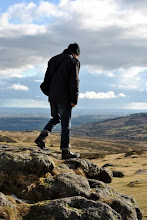
Topogreen, as in topography and green ('like the colour'). So what better way to start this blog than with Dartmoor, which has some serious topography and plenty of green (but few trees - more on this later).
On announcing my intentions to take a weekend break in Dartmoor recently I expected the usual, "Dartmoor, how lovely", comments that usually accompany any mention of any trip to anywhere no matter the relative loveliness, or not, of said destination. Not so this time, "Dartmoor! in February? Good luck!". "No, no", I say, "we always have good weather for holidays. It will be fine". Maybe they had a point I thought, trees don't grow on Dartmoor for a reason (more on this later). But it was not these weather related and possibly sound fears that shook my confidence in a late winter trip to the highest moor in southern England. No, it was a quiet comment along the lines of, "Dartmoor! I've never really seen the attraction of it. People say it's beautiful, but I just don't see it." Well this took me aback and got me thinking about bigger questions on what it is that people 'see' in a landscape.
 As a landscape designer I often fear that too many people do not not really 'see' their surroundings at all, especially in urban areas. In Dartmoor you cannot help, but 'see' the landscape. Grand new vistas leap up at you around each bend and over every hill, each one as arresting as the last. Great granite tors tearing through the earth atop their smooth boggy hills. Ancient settlements and stone circles litter the area while the man made leats still carry clear water across the moor, often appearing to defy gravity.
As a landscape designer I often fear that too many people do not not really 'see' their surroundings at all, especially in urban areas. In Dartmoor you cannot help, but 'see' the landscape. Grand new vistas leap up at you around each bend and over every hill, each one as arresting as the last. Great granite tors tearing through the earth atop their smooth boggy hills. Ancient settlements and stone circles litter the area while the man made leats still carry clear water across the moor, often appearing to defy gravity.Personally I can not help but fall for this spectral place, despite the lack of trees (more on this later). I have heard that in times past Ladies would close their carriage's curtains to hide the craggy hideousness of mountains and hills when travel forced them through such places. Such ideas seem completely foreign to us now since romantic poets and travellers have given us a new way to see the natural world. But do such ideas still exist in ways we shall not understand for generations? Will our poorest cityscape's or nuclear power plants seem more beautiful to our great grandchildren than they do to us?
 Beauty is in the EOTB of course, but the finding of beauty (or not?) in a landscape reveals much more of the beholder, than might be imagined. Dartmoor is not a safe or comfortable landscape to look at. It can be cold and bleak, and looks it too. This could be unsettling for some people, just as forests, and therefore trees, may signify darkness and beasts to others. Understanding the emotional reaction that people have to their surrounding is key to designing the right space for them. Asking a client where they feel most comfortable may be a better question than 'what colour flowers do you like' or 'what's your favourite tree?' Get the psychology right and the garden will follow.
Beauty is in the EOTB of course, but the finding of beauty (or not?) in a landscape reveals much more of the beholder, than might be imagined. Dartmoor is not a safe or comfortable landscape to look at. It can be cold and bleak, and looks it too. This could be unsettling for some people, just as forests, and therefore trees, may signify darkness and beasts to others. Understanding the emotional reaction that people have to their surrounding is key to designing the right space for them. Asking a client where they feel most comfortable may be a better question than 'what colour flowers do you like' or 'what's your favourite tree?' Get the psychology right and the garden will follow.More on trees (or lack of) next week.
